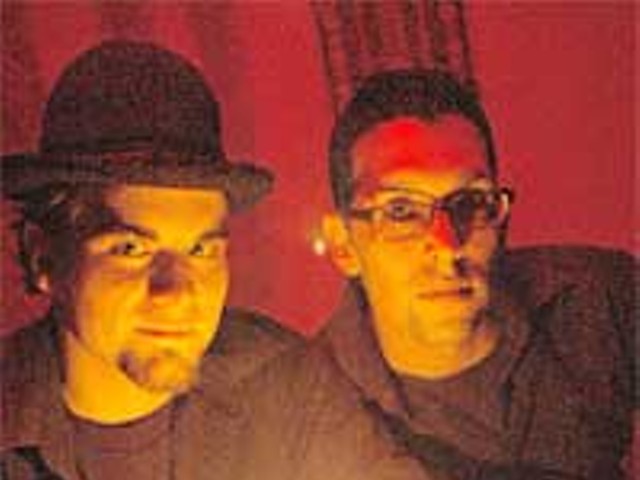Anne Brigman has been called the grandam of California Pictorialist photography and the mother of a photographic tradition spawning the styles of Edward Weston, Maxfield Parrish and Dorothea Langue. But there has to be a less mundane and misogynistic way to describe a radical.
In the early 1900s, Brigman was a mystic who worshipped the Sierra Nevada terrain, a hedonist for its sublime and uncivilized peaks and valleys. During a period when female nudity was intended for the male gaze, Brigman wiped off her rouge and took to the land for weeks at a time, posing for self-portraits in the isolating wilderness by obscuring her face and contorting her naked body. Then, when she returned home to develop the film, she smudged her prints and etched into them, scratching out clouds or her crotch, morphing herself into a creature of mythology. Depending on how you look at these images, she seems to somehow seep into the land or leech from it. But the point is she never lounges seductively.
Cassandra Getty, curator at the Art Gallery of Windsor, was first riveted by Brigman's photography a decade ago, when she read about it in Bram Dijkstra's Idols of Perversity. She says the book posited Brigman's art as unconventional compared with the "cheesecake-like Pre-Raphaelite depictions of women." This summer, Getty has put together an awesome solo show of Anne Brigman's images, most of which are on loan from the George Eastman House in Rochester, New York.
Brigman was born in 1869 near Honolulu, Hawaii, as the daughter of missionaries. Growing up there, she was influenced by local lore and Western literature. After moving to California, she became an artist, poet, actress and feminist. During her active professional period, spanning the first few decades of the 20th century, she was one of two West Coast members of Alfred Steiglitz's Photo Secession and an elected member of the Linked Ring, one of the first fine art photography associations, even though it was primarily a British brotherhood.
This exhibition is presented chronologically and highlights themes, such as Brigman's technically experimental work. Curator Getty notes that the artist, like some of her contemporaries, smudged oil on the camera lens or draped a sheath in front of it to soften the look. But she also shot pictures intentionally out of focus and drew or painted over her prints.
"I claim the right to run the gamut from a lens to a shoe-brush to gain a desired effect," Brigman said. "Daguerre would claim me a heretic." Although most of her photos are silver gelatin or platinum prints, the latter looking like pillow-soft charcoal brushings, she also created intriguing interpositives (images reproduced from photo negatives) on glass.
Like agriculture, photography is a product of the sun. Brigman must have realized the medium's possibilities for capturing the organic. Nature can seem more unreal than any artificial setting, and photo manipulation was her way of gorgeously bastardizing the medium to convey what's wild about the world. In "Travail," an almost headless figure reaches skyward, while the shadow of another nude model huddles at her feet. Some other images are straight-shot photography, but still eerie compositionally. "The Dryad" calls to mind an aesthetic device of a contemporary Japanese horror flick: With hair that looks like a tangled coil of wire (partially the effect of silver emulsion), the artist perches in a Juniper tree, stretching her arm as a branch.
This showcase of Brigman's work has been years in the making, and the curator has done her research, providing several handouts for the public on a range of subjects — from the California landscape to the history of the female nude in art — and fantastic excerpts from the artist's writings. If there is any criticism of the exhibit, it's relatively minor: The lighting seems too soft in a couple of galleries. Also, it would have been a treat had the museum printed a catalog, collecting Getty's essays with reproductions of the artwork, although there are a few good monographs published about the artist.
Anne Brigman was one of the guys, living the life of a single woman alone in New York City for a while and supporting herself financially. She was a good friend of novelist Jack London and, like other artists of that era, kept copies of Leaves of Grass and Towards Democracy in her knapsack — only she read them before stepping to the edge of a crumbling cliff in the blowing wind.
Steiglitz once paid her what he thought to be a compliment, saying she was "one of the most important women in Western photography." But in many ways, she was a better artist than most of the Gatsbys back then, making pretty pictures when they weren't wining and dining. Addicted to the body buzz of lawlessness, Brigman simply refused to recognize limits.
She once said about a particularly risky adventure out West, "The trouble with me — I didn't care. I didn't know the points of a compass and I didn't care. I felt lost; I felt punk and I didn't care."
Through July 31 at Art Gallery of Windsor, 401 Riverside Dr. W., Windsor, Ontario; 519-977-0013.
Rebecca Mazzei is Metro Times arts editor. Send comments to [email protected]




